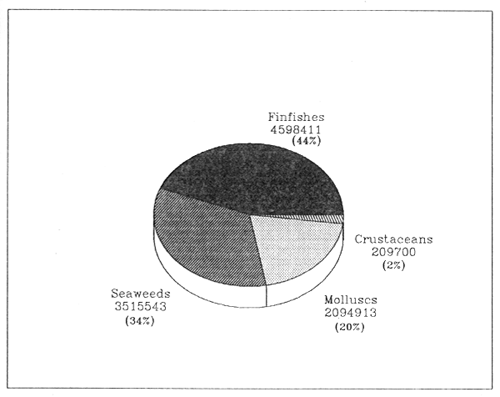by
Alessandro Lovatelli*
I. Country reports
Seaweed utilization as food has a long history in Eastern Asia, particularly in countries such as China, North Korea and South Korea. The importance of these marine plants as a source of nutrients and as components to numerous consumer and industrial products has become increasingly important within the last few decades.
Seaweed collection from natural fisheries has been carried out for a long time, however intensive aquaculture is relatively recent history.
The seaweed aquaculture sector has not developed uniformly in the Asian region. Countries such as China and South Korea have developed sophisticated culture techniques being able to control the entire life cycle of a number of commercially important algae species. In contrast, other Asian countries relay mainly on vegetative propagation such as for Eucheuma in the Philippines. The importance of seaweed output from aquaculture practices is clearly visible from Table 1 and Table 2. Table 1 shows the total production of seaweeds by species in the Republic of Korea from 1980 to 1986, while Table 2 shows the production derived from aquaculture practices. In 1986 the sea mustard (Undaria pinatifida) production output was 354,661 MT of which over 97 % (346,434 MT) was from aquaculture output. Similarly, almost 100 % of the laver produced (Porphyra spp.) was derived from aquaculture.
A great variety of seaweeds are cultured in the region and the total annual production output accounts for a major portion of all maricultured species. Figure 1 shows the aquaculture production in Asia in 1985 by major resource group. Seaweed accounted for 34 % of the year's total aquaculture production next only to finfish which accounted for 44 %.
The species of commercial importance vary according to geographical location. In the northern East Asian countries such as China, North Korea and South Korea major species are Laminaria, Undaria, and Porphyra, whereas Gracilaria, Eucheuma, and Caulerpa are of major importance in the Philippines, Thailand and Malaysia.
The culture methods developed in the region vary considerably depending on seaweed species and country. The giant kelp, Laminaria is mostly being cultured on long-line systems and Porphyra by using a variety of floating net systems. Euchema species are mostly bottom cultured by using the stake and nylon-line method.
The constraints in the seaweed industry vary within each Asian country and depending on species cultured. Major constraints are either related to culture techniques or to marketing problems.
Table 1. Total production of seaweed by species in ROK, 1980–1986 (MT).
| Year | Cracilaria spp. (SEA STRING) | Undaria pinnatifida (SEA MUSTARD) | Laminaria japonica (KELP) | Porphyra spp. (LAVER) | Others | Total Production |
| 1980 | 9 | 206,391 | 3,351 | 56,511 | 50,812 | 317,074 |
| 1981 | 20 | 313,935 | 2,338 | 80,834 | 47,040 | 444,167 |
| 1982 | 10 | 231,236 | 4,748 | 79,957 | 44,580 | 360,531 |
| 1983 | 11 | 242,963 | 12,046 | 88,042 | 47,959 | 391,021 |
| 1984 | 6 | 236,424 | 7,961 | 136,616 | 50,192 | 431,199 |
| 1985 | 2 | 262,816 | 12,792 | 110,422 | 57,542 | 443,574 |
| 1986 | 1 | 354,661 | 9,614 | 143,747 | 48,973 | 556,996 |
Table 2. Cultured production of seaweed by species inROK, 1980–1986 (MT).
| Year | Gracilaria spp. (SEA STRING) | Undaria pinnatifida (SEA MUSTARD) | Laminaria japonica (KELP) | Porphyra spp. (LAVER) | Others | Total |
| 1980 | NA | 196,147 | 560 | 56,274 | 4,899 | 257,880 |
| 1981 | NA | 294,622 | 1,963 | 80,490 | 5,988 | 383,063 |
| 1982 | NA | 225,045 | 3,987 | 79,784 | 5,719 | 314,535 |
| 1983 | NA | 237,128 | 11,606 | 87,963 | 10,530 | 347,227 |
| 1984 | 2 | 230,188 | 7,927 | 136,484 | 9,060 | 383,661 |
| 1985 | NA | 256,436 | 11,796 | 109,819 | 19,410 | 397,461 |
| 1986 | NA | 346,434 | 9,445 | 143,369 | 24,879 | 524,127 |

Figure 1. Aquaculture production in Asia in 1985 of the major resource groups.
II. Future plans
Seaweeds represent a valuable food resource and although their culture in some Asian countries is not yet developed, considerable efforts are being channeled in this sector. In order to further enhance seaweed culture activities among the less developed countries, regional cooperation on research in various aspects of this seafarming sector is considered essential. Training, research and information exchange are the major activities which should be taken into account.
The future of seaweed mariculture in the region will depend to a great extent on how successful market development efforts are. Product diversification will have to be a major activity in order to achieve product introduction and acceptance.